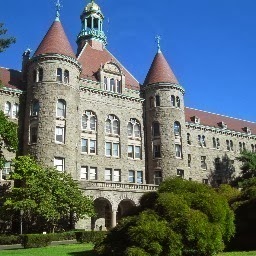DIVISION OFFICERS
Chaplain
Fr. Senan Taylor
President
Dennis O'Brien
Vice President
Robert Eggen
Recording Secretary
Chad Ghastin
Financial Secretary
Michael Flynn
Treasurer
Kevin Hartnett
Chairman Standing
Committee
Ronan O'Brien
Marshal
Andrew Hayden
Sentinel
Justin Kennedy
NEXT MEETING
Wednesday,
Oct. 9, 2020
7:00 PM
Location:
Sprain Lake Golf Course, Yonkers
CONTACT US
Division One
P.O. Box 1020
Yonkers, NY 10703
aohyonkers@gmail.com
A.O.H. LINKS
Powered by Blogger.
Saturday, March 1, 2014
Irish Historian's Report For March 2014
A Priceless Relic of
Faith and Determination
By Mike McCormack
(originally submitted October 1, 2009)
 |
| The McSweeny Chalice |
 |
| Masses were held in caves like this one during The Penal Law era |
In 1399, Henry IV established the House of Lancaster, ending the line of Norman Kings, but he did nothing to revoke the Statutes of Kilkenny. In fact after Henry VIII broke with the Church of Rome in 1534, the Catholic religion was added to the list of restrictions imposed not only upon the English in Ireland, but upon the native Irish as well. England, under Elizabeth, continued to usurp Irish land, force domination on the Irish and suppression of the Catholic faith. In 1607, the last of the Irish Chieftains had been subdued or had departed in the Flight of the Earls, and the Gaelic Order had been broken. Irish clergy were on the run and the price on their head was the same as that on the head of a wolf!
Throughout this escalating reign of terror, the Irish clung to their heritage, their traditions and their religion. Courageous young men went to the continent to be educated and snuck back as ordained priests to keep the faith alive. They celebrated the holy sacrifice of the Mass on flat stones, called Mass Rocks, in secluded valleys and glens, while sentinels kept watch for the sheriff, soldiers, or local constabulary. Sadly, little is known to earthly historians about the valiant servants of God who risked their lives to keep the faith alive, but their biographies are written in gold in the ledgers of the Lord. We do have scattered references however, to a few like the priest named Brady who was known as the Bard of Armagh and Mass Rocks are still venerated for the purpose they served. And, in at least one case, a remarkable relic exists as a reminder of the power of faith. That relic is the McSweeny Chalice and its story is inspirational.
 |
| St. Joseph's Seminary in Yonkers, NY-Home of the McSweeny Chalice |
Today, the McSweeny Chalice is in the care of St. Joseph’s Seminary at Dunwoodie in Yonkers, New York. This writer learned the story of this remarkable artifact at a Communion Mass and Breakfast hosted at the seminary by the AOH Bronx County Board at which the Chalice was used. This magnificent work of art and engineering was designed to break down into three pieces for easy concealment: the cup, the stem, and the base. (The stem fit into the base bottom which was then inverted to fit into the cup). Assembled, the delicately formed cup connects to the stem that is intricately engraved with Celtic patterns, while the base of the Chalice contains designs around a crucifixion scene. Around the edge of the base is a Latin engraving that reads, Pray for the soul of Daniel Swyne,(Sweeny) priest of the diocese of Lismore, who had me made in the year 1640.
 |
| Division 1 holds its Annual Communion Breakfast here at the seminary |
According to an enclosed note, the Chalice was kept in a family of priests named MacSweeny – and secretly carried by them during the Penal Days. It was brought to New York by a priest of that family sometime in the 1800s – probably during the influx of Irish escaping the Great Hunger. What is certain is that in 1898 it was owned by Rev. Patrick McSweeny, who was made pastor of the new St. Brigid’s Church in Manhattan, for he asked Archbishop Corrigan if he would use it in the Mass to consecrate the new Church. At that time, the Chalice was assembled, plated in silver and re-consecrated by Archbishop Corrigan for the need to disassemble and conceal it were gone forever! St. Brigid’s Church later became the scene of controversy when an uncaring diocese wanted to close it down and the Irish community rallied to save it.
The MacSweeny family continued to give a number of its members to the priesthood for by 1908, the Chalice was in the possession of Rev. Edwin MacSweeny. He made the generous gesture of presenting it, as the note relates, to the Great Seminary in New York on the feast of St. Bartholomew, 1908. And there it remains, to this day – a priceless relic of our faith and determination. How ironic, and how appropriate that this Chalice should have been used at a Mass for the AOH, an organization that grew out of the secret societies from Ireland’s past which were organized to protect the clergy during the days of persecution. How often had this very Chalice rested on a Mass Rock in some hidden glen, as the predecessors of the AOH stood guard to protect its use in the holy sacrifice of the Mass?
SOCIAL MEDIA
PARADE LINKS
Here are links to the many St. Patrick's Day Parade Committee websites both locally and nationally.
N.Y.C. Parade
NYC Parade Foundation
Yonkers Parade
Eastchester Parade
White Plains Parade
SoundShore Parade
Peekskill Parade
Pearl River Parade
Bronx, NY Parade
Brooklyn Parade
Queens Parade
Putnam Co. Parade
Dutchess Co. Parade
Savannah, Georgia
St. Patrick's Day.com
N.Y.C. Parade
NYC Parade Foundation
Yonkers Parade
Eastchester Parade
White Plains Parade
SoundShore Parade
Peekskill Parade
Pearl River Parade
Bronx, NY Parade
Brooklyn Parade
Queens Parade
Putnam Co. Parade
Dutchess Co. Parade
Savannah, Georgia
St. Patrick's Day.com
